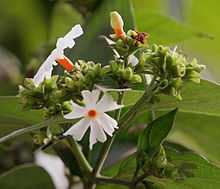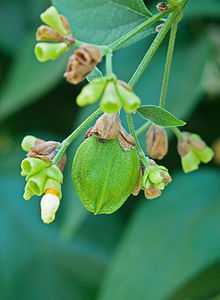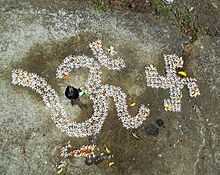Nyctanthes arbor-tristis
| Night-flowering Jasmine | |
|---|---|
 | |
| Scientific classification | |
| Kingdom: | Plantae |
| (unranked): | Angiosperms |
| (unranked): | Eudicots |
| (unranked): | Asterids |
| Order: | Lamiales |
| Family: | Oleaceae |
| Genus: | Nyctanthes |
| Species: | N. arbor-tristis |
| Binomial name | |
| Nyctanthes arbor-tristis L. | |
Nyctanthes arbor-tristis (Night-flowering Jasmine) is a species of Nyctanthes, native to South Asia and Southeast Asia.[1][2][3][4]
Nyctanthes arbor-tristis is a shrub or a small tree growing to 10 m tall, with flaky grey bark. The leaves are opposite, simple, 6–12 cm long and 2–6.5 cm broad, with an entire margin. The flowers are fragrant, with a five- to eight-lobed white corolla with an orange-red centre; they are produced in clusters of two to seven together, with individual flowers opening at dusk and finishing at dawn. The fruit is a flat brown heart-shaped to round capsule 2 cm diameter, with two sections each containing a single seed.[2][3]
Names and symbolism

The tree is sometimes called the "tree of sorrow", because the flowers lose their brightness during daytime; the scientific name arbor-tristis also means "sad tree". The flowers can be used as a source of yellow dye for clothing. The flower is the official flower of the state of West Bengal, India, and for Kanchanaburi Province, Thailand. Nyctanthes arbor-tristis (sometimes incorrectly cited as Nyctanthes arbortristis or Nyctanthes arbor tristis) is commonly known as:
- Night-flowering Jasmine
- Coral Jasmine
- Singgarei in Manipuri
- Sewali (শেৱালি) in Assamese
- Shefali (শেফালী ) or Shiuli (শিউলি) in Bengali
- Parijat (also spelled Paarijat or Paarijaata) in Hindi[5]
- Paarijaatham (పారిజాతము) or Pagadamalle (పగడమల్లి) in Telugu
- Paarijaata (ಪಾರಿಜಾತ) or Goli (ಗೋಳಿ) in Kannada
- Pārijāt (पारिजात), Pārijātak (पारिजातक) or pājakta (प्राजक्त) in Marathi
- Pavazha malli (பவழ மல்லி) in Tamil
- Pavizha malli in Malayalam
- Shephali/Shefali (ଶେଫାଳି) or Ganga Shiuli (ଗଙ୍ଗ ଶିଉଳି) in Oriya
- Sepalika (සේපාලිකා) in Sinhala
In Hinduism

Parijat (Nyctanthes arbor-tristis), appears in several Hindu religious stories and is often related to the Kalpavriksha. In one story, which appears in Bhagavata Purana, the Mahabharata and the Vishnu Purana, parijat appeared as the result of the Samudra manthan (Churning of the Milky Ocean) and Lord Krishna battled with Indra to win parijat. Further on, his wife Satyabhama demanded the tree be planted in the backyard of her palace. It so happened that in spite of having the tree in her backyard, the flowers used to fall in the adjacent backyard of the other queen Rukmini, who was favourite of Lord Krishna.
Pharmacology
Extracts of the seeds, flowers and leaves possesses immunostimulant, hepatoprotective, antileishmanial, antiviral and antifungal activities in vitro.[6] The leaves have been used in Ayurvedic medicine and Homoeopathy for sciatica, arthritis, fevers, and as a laxative.[7]
Chemical constituents
%2C_Kolkata%2C_India_-_20070130.jpg)
- Leaves: The leaves contain D-mannitol, β-sitosterol, flavanol glycosides, astragalin, nicotiflorin, oleanolic acid, nyctanthic acid, tannic acid, ascorbic acid, methyl salicylate, an amorphous glycoside, an amorphous resin, trace of volatile oil, carotene, friedeline, lupeol, mannitol, glucose, fructose, iridoid glycosides, and benzoic acid.
- Flowers: The flowers contain essential oils, nyctanthin, D-mannitol, tannins, glucose, carotenoids, glycosides including β-monogentiobioside ester of α-crocetin (or crocin-3), β-monogentiobioside-β-D monoglucoside ester of α-crocetin, and β-digentiobioside ester of α-crocetin (or crocin-1).
- Seeds: The seeds contain arbortristosides A and B; glycerides of linoleic, oleic, lignoceric, stearic, palmitic and myristic acids; nyctanthic acid; 3,4-secotriterpene acid; and a water soluble polysaccharide composed of D-glucose and D-mannose.
- Bark: The bark contains glycosides and alkaloids.
- Stem: The stems contain the glycoside naringenin-4’-0-β-glucapyranosyl-α-xylopyranoside and β-sitosterol.
- Flower oil: The flower oil contains α-pinene, p-cymene, 1-hexanol, methylheptanone, phenyl acetaldehyde, 1-decenol and anisaldehyde.
- Plant: The plant contains 2,3,4,6-tetra-0-methyl-D-glucose; 2,3,6 tri-0-methyl-D-glucose; 2,3,6-tri-0-methyl-D-mannose; 2,3,-di-0-methyl-D-mannose; arbortristosides A, B, and C; and iridoid glycosides.
Biological activity
- Leaves: Antibacterial, Anthelmintic, Anti-inflammatory, Hepatoprotective, Immunopotential, Anti-pyretic, Antioxidant and Anti-fungal. Its new leaves are fried and used as a recipe in some Assamese and Bengali cuisines.
- Flowers: Diuretic, Anti-bilious, Antioxidant, Anti-inflammatory, Sedative and Anti-filarial. Its dried flowers are used as components of recipe in Assamese food.
- Seeds: Antibacterial, Antifungal, Immunomodulatory and Antileishmanial.
- Bark: Anti-microbial
- Stem: Antipyretic and Antioxidant.
- Flower oil: As perfume
Gallery
-
%2C_Kolkata%2C_India_-_20070130.jpg)
Bark in Kolkata, West Bengal, India.
-
%2C_Kolkata%2C_India_-_20070130.jpg)
Leaf, from below, in Kolkata, West Bengal, India.
-
%2C_Kolkata%2C_India_-_20070130.jpg)
Foliage and fruit in Kolkata, West Bengal, India.
-

Flowers in Kolkata, West Bengal, India.
-
flower bud at Madhurawada, Andhra Pradesh, India.
-
Flower, in Delhi
References
- ↑ Germplasm Resources Information Network: Nyctanthes arbor-tristis
- ↑ 2.0 2.1 Flora of Pakistan: Nyctanthes arbor-tristis
- ↑ 3.0 3.1 AgroForestry Tree Database: Nyctanthes arbor-tristis
- ↑ Kew World Checklist of Selected Plant Families, Nyctanthes arbor-tristis
- ↑ Our Tree Neighbours, by Chakravarti Venkatesh, 1976
- ↑ Puri A, Saxena R, Saxena RP, Saxena KC, Srivastava V, Tandon JS (March 1994). "Immunostimulant activity of Nyctanthes arbor-tristis L". J Ethnopharmacol 42 (1): 31–7. doi:10.1016/0378-8741(94)90020-5. PMID 8046941.
- ↑ Saxena RS, Gupta B, Lata S (August 2002). "Tranquilizing, antihistaminic and purgative activity of Nyctanthes arbor tristis leaf extract". J Ethnopharmacol 81 (3): 321–5. doi:10.1016/S0378-8741(02)00088-0. PMID 12127232.
External links
| Wikimedia Commons has media related to Nyctanthes arbor-tristis. |

